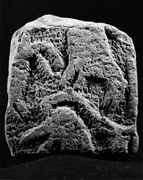Select a site alphabetically from the choices shown in the box below. Alternatively, browse sculptural examples using the Forward/Back buttons.
Chapters for this volume, along with copies of original in-text images, are available here.
Object type: Part of cross-shaft and -head
Measurements: H. 25.4 cm (10 in); W. 22.9 cm (9 in); D. 15.2 cm (6 in)
Stone type: Medium-grained yellow sandstone (Carboniferous)
Plate numbers in printed volume: 406 - 9
Corpus volume reference: Vol 2 p. 123-124
(There may be more views or larger images available for this item. Click on the thumbnail image to view.)
Rectangular cross-shaft.
A (broad): Only part of the shaft ornament remains on this face with a roll-moulded border on the right side. The surviving panel contains three crudely-drawn animals. On the right is the head, upper body and two front paws of one beast; the belly, four paws, and lower jaw of another appear at the left edge and the tail, rump, rear legs, and (presumably backward-turned) head of a third animal occupy the rest of the panel. The eye of this latter animal is drilled and its ears pierce the border moulding.
B (narrow): Scrollwork.
C (broad): At the top there are traces of interlace on the remains of the free-armed head. Beneath the border which separates head and shaft is a ten-strand plain plait bounded by a roll moulding on the left-hand side.
D (narrow): Cut away.
The persistence of strong Anglian traditions is signalled by the free-armed head and the scroll, for which the closest parallel comes from Penrith (no. 2). The free-style animals are of a type which recur frequently around the Viking-period Irish sea in an area embracing north Wales, the Isle of Man, south-western Scotland, north-western England and the Norwegian-settled areas of Yorkshire (e.g. Nash-Williams 1950, nos. 38, 190; Kermode 1907, nos. 66, 72, 93, 97–8, 100, 102–3, 105; Allen 1903, figs. 443, 471, 478, 483; Collingwood 1907a, 320, 339, 400, 406; Cramp 1984, pl. 147, 774). The ultimate origins of this style are disputed; it may draw on an Insular tradition but could equally derive from Scandinavia, where similar treatments are found (Wilson and Klindt-Jensen 1980, pls. XIX, XXVI). The placing of the animals in a non-horizontal plane recalls Manx arrangements and, locally, Gosforth 1; perhaps all independently reflect a Scandinavian tradition of wood-carving.



